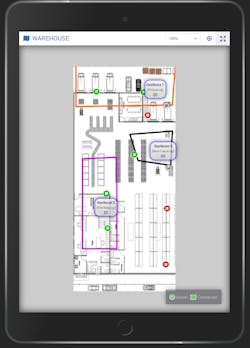Imagine this: you’re on the factory floor, attempting to assemble a piece of equipment. However, not every part, or asset, is quick and easy to locate in such a large manufacturing plant. And with customized consumer demands and soaring productivity quotas to meet, there’s not a minute to lose.
Reading the operating procedure, you determine the next asset needed for assembly—but it’s not at your workstation. It doesn’t seem familiar. Where would those even be?
You trigger the andon, signaling for help. It’s starting to feel like a classic case of searching for a needle in a haystack. And even if the asset is found after looking for a few minutes, that’s wasted time that would push back productivity levels.
If this scenario sounds familiar, whether from personal experience or otherwise, you’re likely not alone. For manufacturing workers, as well as their managers and executives, time is of the essence. And with so many assets packed together in inventory, getting the right part to the right place at the right time can be a significant challenge. This issue can cause operational slowdowns or standstills with both assets and finished products.
To top this all off, the manufacturing industry is currently in the middle of a generation-defining worker shortage. A Deloitte and Manufacturing Institute study found that 2.1 million manufacturing jobs could remain unfilled by 2030, further driving the need for employees to work as efficiently as possible.
That’s why manufacturers are leveraging the power of the Industrial Internet of Things (IIoT) to help bridge the gap.
The Technology of the Future
IIoT refers to using a series of interconnected sensors and other devices to improve manufacturing and industrial processes, from streamlining picking and replenishment with paperless tags to providing location data for various assets on the factory floor.
Outdated paper-based processes are highly error-prone and inefficient when it comes to ensuring the correct parts are located and selected manually by operators. Unfortunately, a recent customer survey we conducted found that over 80% of engineers in automotive manufacturing said their material flow processes still rely on “lots of paper.”
However, this is an incredible opportunity for companies to future-proof their operations for years to come with IIoT. By providing real-time tracking solutions of both parts and processes, IIoT technology allows manufacturers to control costs, improve efficiencies and maintain productivity.
You may be wondering: how exactly does IIoT help operators locate assets and containers quickly enough to justify the investment? Well, as I always like to say, a picture is worth a thousand words.
Tracking Your Operations—on a Screen
One example of IIoT’s transformational power is in the tracking of what we call “smart containers.” Smart containers refer to containers or assets on the factory floor that use RFID tracking technology to provide real-time updates on location in the warehouse. IoT systems can combine RFID tracking with e-paper displays to send instructions to operators based on rules (if/then logic) that are set up to define where containers should be at any given point in the process.
By using smart tags on various containers and assets on the factory floor, tag location and status can be instantly communicated to workers needing the information. Instructions on the tag can be updated to indicate where the material needs to go next, and a text message can be sent to a manager if the material is idle for too long or is in the wrong location. Constant communication allows for a seamless flow of information that keeps production moving at a steady pace.
The map below visualizes where an asset or container is located directly in IIoT software (see Figure 1).
The asset dashboard (see Figure 2) also shows location coordinates and provides information such as time and alerts for real-time tracking.
Aside from the benefits of receiving real-time location updates to share with operators, management can leverage the data analytics provided by IoT to improve their operations. For instance, a manager could determine the specific amount of time that containers and assets spend at each workstation. This allows for visibility of bottlenecks and can drive improvement to optimize the process. Analytics also enable process monitoring remotely, ensuring managers and team leads can detect problems quickly and intervene when necessary to keep things moving.
With IIoT, smart tags can change in an instant to provide quick, accurate instruction to operators as changes in production or priority occur. For example, if the end location of completed products changed on a dime, smart tags would immediately relay this change to operators to ensure they didn’t miss a beat.
Not only can smart tags change based on location, but a change in location can also trigger automated workflows. After a pallet is done being used and returned to its original location, IIoT can actually update workflows to let users know that pallet is available for use.
That’s a level of flexibility that’s near impossible with paper labeling. Tack on the ability to control costs and improve efficiencies by getting all parts and containers to the right place at the right time, and it’s a no-brainer.
Help Your Employees Help You
By ensuring workers know where material is located and what to do next, manufacturers can keep productivity levels high even during worker shortages. As companies evolve, adopting smart manufacturing is a smart strategy to drive growth for years to come. And the Industrial Internet of Things is a great way to begin that journey.
Helen Titus is marketing director, Industrial IoT Solutions, with Panasonic North America, a provider of integrated supply chain and mobility solutions.





